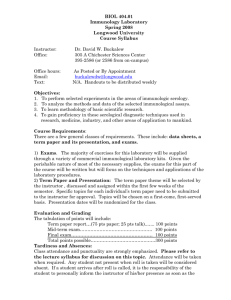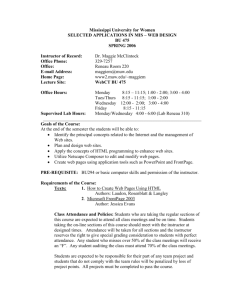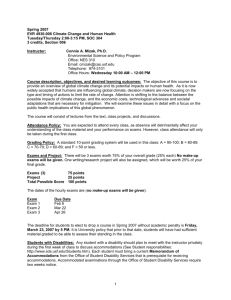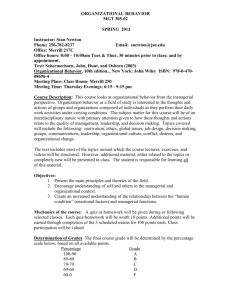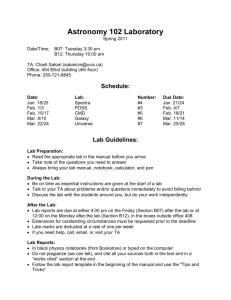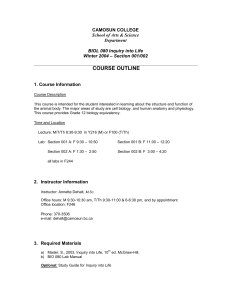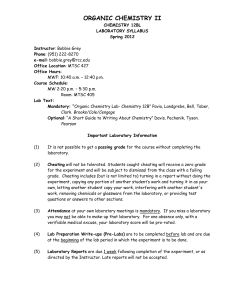Advanced Lab 1 - The University of West Georgia
advertisement
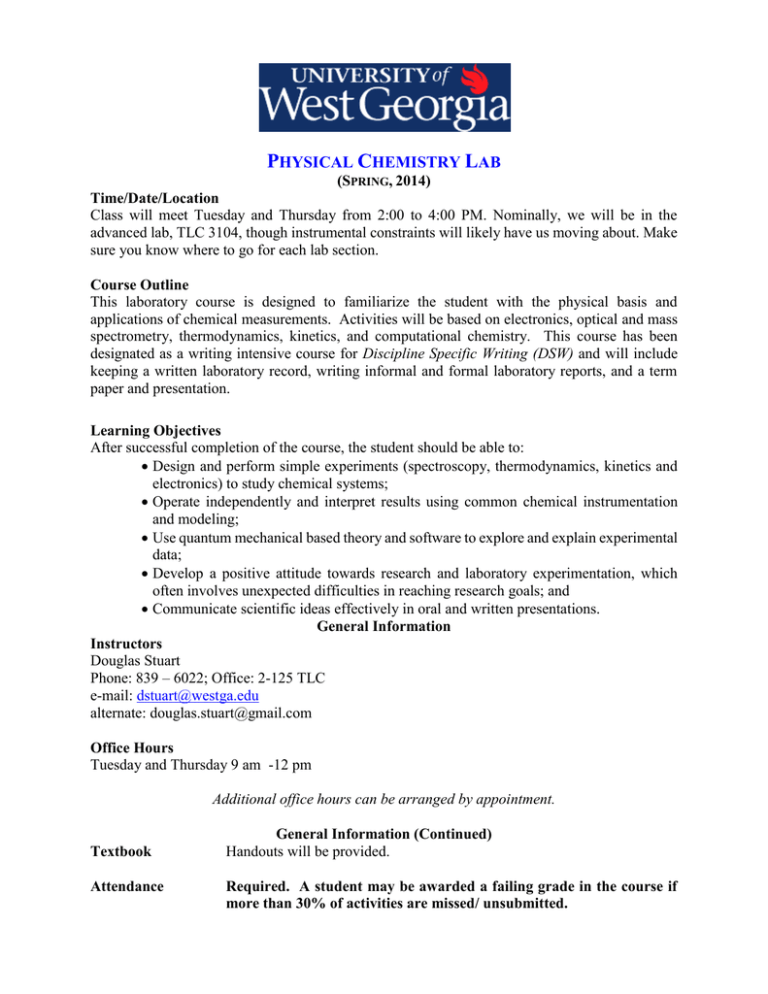
PHYSICAL CHEMISTRY LAB (SPRING, 2014) Time/Date/Location Class will meet Tuesday and Thursday from 2:00 to 4:00 PM. Nominally, we will be in the advanced lab, TLC 3104, though instrumental constraints will likely have us moving about. Make sure you know where to go for each lab section. Course Outline This laboratory course is designed to familiarize the student with the physical basis and applications of chemical measurements. Activities will be based on electronics, optical and mass spectrometry, thermodynamics, kinetics, and computational chemistry. This course has been designated as a writing intensive course for Discipline Specific Writing (DSW) and will include keeping a written laboratory record, writing informal and formal laboratory reports, and a term paper and presentation. Learning Objectives After successful completion of the course, the student should be able to: Design and perform simple experiments (spectroscopy, thermodynamics, kinetics and electronics) to study chemical systems; Operate independently and interpret results using common chemical instrumentation and modeling; Use quantum mechanical based theory and software to explore and explain experimental data; Develop a positive attitude towards research and laboratory experimentation, which often involves unexpected difficulties in reaching research goals; and Communicate scientific ideas effectively in oral and written presentations. General Information Instructors Douglas Stuart John Hansen Phone: 839 – 6022; Office: 2-125 TLC Phone: 839 – 6021; Office TLC 2-123 e-mail: dstuart@westga.edu alternate: douglas.stuart@gmail.com Office Hours Tuesday and Thursday 9 am -12 pm Additional office hours can be arranged by appointment. Textbook Attendance General Information (Continued) Handouts will be provided. Required. A student may be awarded a failing grade in the course if more than 30% of activities are missed/ unsubmitted. Grades Your grade will be calculated based on the following components: Lab Reports Term paper Presentation Examinations (2) TOTAL 60% 10% 10 % 20% 100 % __ Thus to calculate your overall grade; GRADE = (Projects ×.2)+( Exams Avg × .2)+(Formal Reports Avg × .3)+(Informal Reports ×.3) Letter grades [90% - 100% = A] [80% - 89% = B] [70% - 79% = C] [60% - 69% = D] [0% - 59% = F] Exams There will be two exams in this course. Each exam will consist of a written section, and the final will also have an oral component. The written portion of the exams will be on 3rd March and 1 December during class time. The oral exams are scheduled for May 3rd and 5th (during exam time, 11 am-1 pm). E-mail Policy The primary means of communication with the instructor will be via the e-mail associated with CourseDen. Since email has proliferated, and now constitutes the bulk of extra-classroom conversation between student and instructor, it must be subject to normal rules of formality. Therefore, all e-mail communication will follow the guidelines enumerated here. Email should be composed in formal, professional language, and with attention to the propriety accorded to the position of the writer, and the addressee. E-mails that do not meet these standards will not be returned by the instructor. E-mail should not ask questions whose answers are contained in the course syllabus. Such e-mail will not be returned by the instructor. Students should avoid asking questions in e-mail that should be raised either in class, or in individual consultation with the instructor. These include questions of an excessively conceptual nature, and questions that expect an unreasonable amount from the instructor. A good rule of thumb: if you question cannot be answered in two sentences or less, or if it is a question that you should solve on your own through the course of your reading, then it is not appropriate for e-mail. Lastly, email will only be answered during normal work hours (9am – 5pm) Monday through Friday. Emails sent outside of those hours, or on the weekends, will not be returned until the resumption of normal business hours. Writing Lab Reports One of the purposes of an advanced laboratory course is to provide experience in writing scientific reports. In accordance with the DSW requirement, grade each report using a grading form, but we will also provide detailed editing and commentary on select reports. Resubmission of your report may occur if we deem it necessary. Please pay close attention to avoiding calculation errors, since these can ruin the most carefully gathered data. Also, visit the library and look at articles from a current issue of Physical Chemistry or any other ACS grade journal to familiarize yourself with the writing style used in scientific publications. Submission Laboratory Reports 2 In furtherance of the University goal of being at the apex of technologically integrated teaching, we will be using online submission of laboratory reports via CourseDen. Lengthy calculations are difficult to compose in word processors, and thus may be submitted on paper, provided they are complete and legible. Any figures, tables, spreadsheets (e.g. material produced on the Microsoft Office suite) that can be included in the corpus of your report should be integrated into the submitted document file. An example writing sheet will be provided. Submit your reports to course den with the following file format: lastname_lab#_labname.doc e.g. stuart_lab1_heatofvap.doc Peer Review of Laboratory Reports After your paper has been submitted via course den, the identifying information will be removed and the report given to another student in the class for evaluation and editing. The evaluating reviewer will take the roll of scrutinizing the paper and thoroughly evaluating it, e.g, checking completeness, style, scientific reasoning, data handling, error analysis etc. The evaluator will use red ink for all corrections and comments. The evaluator is to be as thorough as possible, since the review will count as 10% of the grade for the evaluator’s own lab report. The review is due at the start of the next lab session after the report is received. Thus, if a lab is completed on Thursday the 1st, the author has until Thursday the 8th to complete the lab report. This will then be given to a reviewer, who will then have until the Tuesday the 13th to complete the review. Policy on Late Laboratory Reports The schedule of experiments will be provided in a subsequent handout. All laboratory reports are due one week after the experiment is completed. A 10% per day penalty will be assessed for each day the report is late. If the report is not turned in by the fifth late day, the laboratory report will be considered unsubmitted, and will not be accepted. It is our policy to administratively withdraw a student from this course with a WF if they fail to turn in more than two laboratory reports within the stipulated time. Laboratory Notebook A laboratory notebook should provide a permanent record of details in procedure, raw data, observations, calculations and results. The criterion for sound record keeping is that someone else should be able to readily locate and understand the pertinent results for an experiment. Although reasonable legibility and neatness are required to meet this criterion, the utility of a record is determined largely by whether it is original, systematic, and complete, not by whether it is a work of art. The following are guidelines for keeping a proper experimental record: 1. A bound notebook is required for this lab. Numbered pages are required, as is a table of contents. 2. Enter all data in ink as soon as it is taken. Never recopy numbers or use loose sheets of paper. Cancel errors or rejected data by drawing a single line through them. Do not erase or remove pages. Set aside the first two pages of the notebook for a table of contents, which you will organize at the end of the course. 3. Enter data only on the right page of the two facing pages (optional). Use the left side as a scratch sheet for calculations. 4. Clearly label all entries, including the units (e.g. grams). To facilitate direct recording of experimental work, it is helpful to set up a data page for each experiment before coming to the lab. 5. Even if the calculation of final results from the data taken in lab is done at a later time, record these calculations in your notebook for future reference. To avoid errors in the calculations, write out each step of the calculation. This step is of particular importance, should your report and notebook become separated later. 3 Report Format All reports will be written on a word processor. Students will make use of spreadsheet and plotting software in their reports. They are encouraged to plot data as soon as it is obtained, if possible, so that problems may be detected early and not the night before the write-up is due. Sloppy reports will not be graded and will be returned to be rewritten. Correct use of English is expected in all reports. If in doubt about spelling, look the word(s) up in a dictionary or run a spell checker. Be specific and concise in reports, especially in the introduction and discussion. It is recommended that the report be read by another student before submission, and at the least, the student should read aloud the report as written to check for blatant errors, poor grammar, or incomplete thoughts. Formal Reports The student will be graded using the following format: 1. Title: Title of experiment, together with your name, department, and college should appear on a separate title page which is not counted in the 10-page limit. 2. Abstract: A one-paragraph (five to 10 sentences) abstract must be included on the lower half of the title page. The purpose of the experiment should be stated and the results summarized. 3. Introduction: Outline the theory of the experiment; use schematics when possible. The line of reasoning upon which the experiment is based must be presented in a careful and logical manner. 4. Experimental: A brief but descriptive outline or statement of the procedure should be included. Emphasize any changes of the procedure prescribed in the experiment handout. A neat sketch of the apparatus is useful. Label all parts of the drawing. 5. Data: Organize the data carefully into tables and/or graphs where appropriate. Include with every numerical entry an estimate of its uncertainty and the units. When several determinations are made of the same quantity, the standard deviation of the average should be used to indicate uncertainty. A spreadsheet and plotting program must be used for the graphs. 6. Calculations and Results: One example of each calculation should be given. Each result should be accompanied by an estimate of its uncertainty (e.g. standard deviation). For replicate determinations, the final value of each sample can be calculated, the results averaged and the standard deviation can be calculated. Alternatively, an uncertainty may be estimated by propagating the uncertainties with the raw data. Learning to estimate errors and see how they propagate through the calculations into the final result is one of the most important aspects of this laboratory experience. For linear data, use least-squares analysis when appropriate. 7. Discussion with error analysis: Discuss how the results correlate to the theory presented in the introduction. From the statistical analysis data, discuss the significance of the results obtained. Consider whether the precision of the results is reasonable for the particular method of analysis. Describe any potential sources of determinate or systematic error. 8. Conclusion: Summarize your numerical results and scientific conclusions, with appropriate error. Term Paper and Presentation on Physical Chemistry Techniques Each student will choose an analytical/physical technique that is not explicitly covered in this course and write a 10-page, double spaced, font size 12, 1 inch margins term paper. The paper 4 should discuss the scope, theory and impact/application of the technique in the form of examples published in the chemical literature. In addition, each student will give a 20 minute presentation in class on the selected technique, preferably using Powerpoint. The assignment on the term paper will be broken into four parts: I. Topic Selection – submit an abstract of your topic with five references. The references must be recent (last 3 years) and cannot be textbooks, internet sites. Please attach the abstracts from the five references. Due on Tuesday, February 4th. II. Initial Draft – submit a 10-page (excluding figures) draft of your paper for editing. Due on Tuesday, March 25 , 2011. III. Final Paper – submit the 10-page final draft of your paper along with a copy of your initial draft. Due on Tuesday, April 17th. IV. Oral Presentations will be held on April 15-17th. Policy on Cheating Occurrences of cheating are rare. However, cheating by one individual raises questions about fairness for the rest of the class endangers the honor code that governs our examination system. It is after considerable thought and agonizing that we have arrived at the following formula. If an individual cheats on a report for the first time, he/she will obtain a score of zero for that particular report. If an individual is caught cheating a second time during the semester, he/she will receive a grade of F for the entire course. 5 Tentative Time Table for Experiments Class Date Day Subject 1 7Jan T Introduction 2 9 Jan R Error Analysis 3 14 Jan T Heat of Vaporization of Water 4 16 Jan R 5 21 Jan T IR Spectroscopy of HCl/DLC 6 23 Jan R 7 28 Jan T Conjugated Dyes/ Particle in a Box 8 30 Jan R Topic Selections Due 9 4 Feb T Mass Spectrometry (lecture) 10 6 Feb R Mass Spectrometry lab 11 11 Feb T Nanoparticle Adsorption Isotherm 12 13 Feb R 13 18 Feb T 14 20 Feb R Mid TERM 15 25 Feb T Calorimetry 16 27 Mar R 17 4 Mar T Penicillin Hydrolysis Kinetics 18 6 Mar R 19 11 Mar T Raman Spectroscopy of Functional Groups 20 13 Mar R 18 Mar T no class 20 Mar R no class Phase Diagram (Draft Due) 21 25 Mar T 22 27 Mar R Polarimetry: Inversion of Sucrose 23 1 April T Stokes Shift/ Fluorescence 24 8 April R 25 10 April T Fluorescence Quenching 26 15 April R oral presentation 27 17 April T Paper Due/ oral presentation 22/24 April T/R FINAL ORAL EXAM 2-4 P.M. 6 Score SAFETY RULES: PHYSICAL CHEMISTRY LAB As a student, I will adhere to the following safety rules: 1. I will follow all general and specific instructions given by the instructor for a lab activity. 2. I will study my assignment. If I am in doubt about any procedure, I will ask the instructor or one of the laboratory assistants for help. 3. I will not perform activities that are unauthorized, nor will I engage in inappropriate behavior while I am in the laboratory. 4. I will dress sensibly and appropriately for lab. I will avoid long, loose sleeves, dangling ear rings and other large items of jewelry, and clothing that interferes with movement. I will not work in the laboratory with bare feet, open-toed shoes, or high heels. 5. I will wear protective eyewear (safety glasses or goggles) throughout the entire period that I am in the laboratory. 6. I will use the safety equipment provided when needed. I will become familiar with the locations of the fire extinguisher, the safety shower, the eye wash, and the first aid kit. 7. I will immediately report to the instructor any accident, injury, incorrect procedure, or damaged equipment. 8. I will place broken glass and waste chemicals in designated containers. I will not dispose of any hazardous chemical down the sink. If I am not sure of how to dispose of any chemical, I WILL ASK MY SUPERVISOR! 9. I will not bring into the laboratory any food, drink, chewing gum, or tobacco products, except for what may be stored in book bags. 10. I will follow good housekeeping and good safety procedures in cleaning spills, replacing caps on containers, and replacing materials that are for general use. 11. I will wash my hands thoroughly immediately after leaving the laboratory. 12. I will report the loss or breakage of any materials, or any damage of any instrument immediately. 7 STUDENT AGREEMENT: PHYSICAL CHEMISTRY LAB Please acknowledge that you are prepared to start class by initialing the following statements and signing the document below. This will help to ensure that we are all aware of the basic operation for advanced instruction in chemistry. Statement Initial 1. I have read and understood the safety rules above _____ 2. I know how to calculate my grade _____ 3. I am aware of the policy on late submission of lab reports, and the requirement that they be submitted electronically. _____ 4. I know the exams will have written and oral components. _____ 5. I am aware of the e-mail policy. _____ 6. I have read the syllabus and know the due dates for my paper, and the exam schedule. _____ 7. I keep a neat and complete lab notebook. _____ ______________________ Printed Name _____________________________ Signature 8 _________ Date
